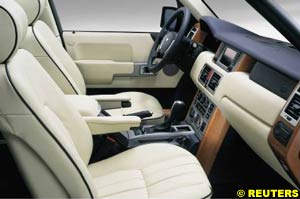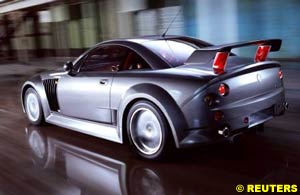

Automotive News and Reviews for the Petrolhead
Reuters Motoring Commentator
In this week's issue:
- Best Seat in the House
- Rover's Classic Legacy
I have it on excellent authority that the man responsible for designing the latest Range Rover began the process with the driver's seat. His objective was to respond to existing Range Rover customers' comments and create a car that offered the ultimate sense of authority and control from behind the wheel. Well he got that bit right.
Instantly, you become aware of your own superiority. You acquire a certain majesty and, ultimately, you truly feel untouchable. And quite possibly, you haven't actually set off anywhere yet. Simply sitting behind the wheel of the latest Range Rover (particularly if that Range Rover is a V8 Vogue model) is an emotional experience and these are emotions that transcend all boundaries of class or outright wealth. The Range Rover has long been the preferred choice of the aristocracy and the Chairman of the Board, but is also the perfect lifestyle accessory for soccer stars and pop princesses, not to mention the felonious fraternity. Be it a society picnic or a high-street ram-raid, the Range Rover has always been a high profile motor and it is not difficult to see why. It is a car that makes you feel a million dollars, just by being in it and, in the field of 4x4 vehicles, this makes it peerless.
When BMW acquired Rover in the Nineties, Land Rover was part of the deal and the Range Rover was of more than just a passing interest. In 2000, BMW sold Land Rover to Ford and again, Range Rover was the major motivation. By now, BMW was developing its own 4x4 vehicle, the equally acclaimed X5, and during the BMW/Ford transition there was a degree of crossover between the two products. As a consequence, the Range Rover makes excellent use of a range of BMW petrol and diesel engines, including the 4.4 V8 fitted into the Vogue, and much of the Range Rover's switchgear will be familiar to BMW drivers.
This is no bad thing, but comparing the two vehicles is a pointless exercise, much like looking for the similarities between a Nike trainer and a Church's brogue. Each is essentially a high-quality shoe but they fulfil two quite distinct purposes. And there are some basic but quite startling differences between the two cars, like their respective sizes for a start. The Range Rover dwarves the X5. There are also more interesting technical differences, such as the fact that the Range Rover has a 50:50 power transfer split (front/rear) to facilitate exceptional off-road ability but the X5's is shared 30:70 (front/rear), helping to explain its superior sporting handling characteristics. Even in terms of overall build quality there is a difference, the BMW still a little ahead of the ?Ford in this regard.
But ultimately, the real difference is in class, and class, heritage, breeding, call it what you will, cannot be designed, engineered or ordered as an expensive option. You either have it or you don't. The X5 is an outstanding car, the better driver's car, the better-built car, but it is not a Range Rover and for those in the know, this name counts double. Despite its size, somehow the Range Rover is just a little less obvious, a little more refined, whether you're a landowner, a businessman, a footballer, his wife, or a thief!
Off-road, the ride height is raised 50mm above normal and because all four corners of the car are independently suspended, but also electronically cross-linked, the most awkward of ditches and slopes can be tackled with confidence, each corner of the car being kept moving in a vertical plane. The car is even clever enough, when being operated with Hill Descent Control engaged, to recognise when you are reaching the bottom of a slope. In situations where the car's attitude is particularly extreme, the front suspension automatically raises the front of the car further, to guard against grounding the nose as you approach flatter ground.
And all the while, on-road or off, you are sat inside one of the most opulent cabins ever designed. Everything you would expect (leather, satellite navigation, electrically operated seats) is included in the price, together with considerably more you might not (heated steering wheel, heated seats all-round and a TV not heated, to the best of my knowledge). Minor moans were restricted to the only ever-so-slightly below par fit and feel of the fixtures and fittings, more a state of mind than any bad experience, and the inevitable alarm at the car's galloping thirst. But it somehow seems rather inappropriate to spend a week lolling around the countryside in a 2500 kilo, V8-powered luxury off-roader and then start carping about mpg figures.
Whether you're an establishment figure or a tabloid poppet, you'll be smitten by everything the Range Rover offers and quite probably unbothered by its uneconomical habits. If you've got the money, it's that kind of a car. Its heritage and style will impress you; its appearance and authority will seduce you. And once you experience the feeling you get from the driver's seat, you'll be sold.
At the centre of the Rover badge there is an image of a Viking longboat, sails unfurled, approaching head-on at full speed.
I am not sure which came first, the image of the boat or the company name, but the word 'Viking' is Norse for 'sea-rover', so the connection between badge and name cannot be misunderstood.
Nor, sadly, can the irony of the link between the famous Viking pastimes of rape and pillage and Rover's own choppy waters over the past 40 years. At the end of the Sixties the company, including Land Rover, was swallowed whole by British Leyland, one of Britain's all-time nationalised industry disasters. Rover's model range was beginning to show its age but in 1976 BL introduced a potentially great replacement, the SD1 model. This new Rover was bold (slightly futuristic-looking even), powerful and spacious but in-between their strikes and tea breaks, British Leylandıs heavily militant workforce built it from detritus, while wearing mittens, and this brave new Rover gained a ruinous reputation as an unreliable rust-bucket.
Passing on the Badge
In 1988, the baton passed to British Aerospace although nobody knows why, including British Aerospace itself. For six years Rover stagnated, until 1994 when it was sold to BMW. Almost a decade on, it is tempting to speculate that BMW simply agreed to the deal for a laugh but, as BMW is German, this is naturally unlikely. Not noted for their roustabout joviality in Bavaria, are they?
Any laughter there may have been as one of the world's leading automotive brands clasped what it referred to as its 'English Patient' to its bosom, soon turned to tears. Despite having made firm commitments to nurse poor old Rover back to health, the small issue of haemorrhaging £1,000,000 of its own cash every day to do so proved too much to bear. And anyway, BMW had by now realised the full horror of what it had done. Understandably (in some ways), it decided it would rather say nein to an ageing model range, poor productivity record and pre-World War II factories but ja to building a funky new MINI and keeping hold of what was left of its own cash.
And so, two years ago, it sold off Land Rover to Ford for £1.85 billion and MG Rover to a private consortium called Phoenix Holdings - for a tenner. Finer financial detail need not trouble us here but, superficially at least, this doesn't seem an awful lot of money to pay for a large car company (but is most certainly symbolic of how desperate BMW had become to dispose of Rover).
Prior to its (in)digestion by British Leyland, Rover was noted for building handsome, comfortable sporting saloons such as the P5B and 3500 V8, although another burden the brand has, for many years, had to bear is a reputation for producing 'old man's cars.' As Rover has been busy picking its friends so badly these past few decades, so the model ranges have continued to be just a little bit Horlicks and hot-water bottles.
But it would be boring and irresponsible to simply trot out a witty list of Bournemouth-isms to describe Rover just now. Aside from the fact that MG Rover Group Ltd, a division of Phoenix Venture Holdings Ltd remains up against it financially, it needs support, not ridicule. And it deserves it too. While the current range is still more Land of Hope and Glory than Cool Britannia, there are signs that the issue of brand perception is being addressed head on.
In 2000, British design guru (and long-time MG fan) Peter Stevens was appointed Product Design Director. Previously, Stevens had a hand in the awesome McLaren F1 road car and was responsible for helping Lotus back onto the right road with the acclaimed M100 Lotus Elan. The initial fruits of his labour have already been seen, through the ZR, ZS and ZT range of MG Rovers. This collection of warmed-over, and sometimes hot, Rover 25, 45 and 75 models offers a more dynamic driving experience than the less flamboyant standard models and each comes clothed in subtly appended bodywork and a range of bold, contemporary colours. These models are a step in the right direction, as are this year's factory supported race programmes. The old Ford adage of 'win on a Sunday, sell on a Monday' cannot be far from MG Rover executives' collective minds.
Lock and Load
In reality the SV is a V8 powered, two-seater sports car that can be ordered with a factory-approved nitrous-oxide injection system, offering up to 965bhpand 200mph performance. Take your teeth out Nana, because 60mph will be passed in only slightly more than four seconds. It is fantastic thing. No wonder it comes with two helmet holders behind the seats.
A Classic Model
But at £65,000 for the base model, the SV is a little spoon of jam alongside the bread and butter quantities of saloons and hatchbacks that Britain's biggest car company must sell in order to survive. Take the Rover 75 for example. In the long-standing tradition of Rovers it is handsome, capable and imbues a decent sense of quality and prestige. I recently drove the Club SE spec 1.8T Tourer and smashing company it was too. Finished in Monogram Chatsworth Supertallic, with an Eden Green Classic full leather interior (all very Rover) from the bespoke, but bewildering, Monogram range of options, it did nothing to either excite or offend (aside from having a driving position which, much like all current Rovers, leaves you feeling 'perched' with the steering wheel in your lap) but was somehow more classy while it did/didn't do it. And at £20,675 for the base model, the Rover is competitive in its sector with both the hordes (Ford Mondeo/ Renault Laguna) and the Lords (Audi A4 Avant, Lexus IS200 Sportcross).
In every way, the 75 is a Rover in the classic mould but Rovers in the classic mould have not thus far helped the company sustain financial success. Perhaps the sensational X Power SV, as a portent of things to come, will prove to be the MG Rover that broke that mould, paved the way for a range of more aspirational cars and saved Rover from becoming, like the Vikings, yet another footnote in the pages of history.
![]() Best Seat in the House
Best Seat in the House
 Since launch last year, the MkIII Range Rover has been feted as the car it always should have been and has won a string of awards. Its looks, clever dynamics and all-round abilities have all secured industry acclaim, but the real key to the new Range Rover's irresistibility is the way it makes you feel. And it all starts with the view from the driver's seat.
Since launch last year, the MkIII Range Rover has been feted as the car it always should have been and has won a string of awards. Its looks, clever dynamics and all-round abilities have all secured industry acclaim, but the real key to the new Range Rover's irresistibility is the way it makes you feel. And it all starts with the view from the driver's seat.
 But even for the cognoscenti, image and a badge alone will never justify a £60,000 price tag (£59,995 for the V8 Vogue). Fortunately, there is more. Remember, at one extreme this car has been designed to glide between Harvey Nichols and Home House in the week, while still being able to cope with being wheel-deep in mud at a Gloucestershire gymkhana at the weekend. The perception may be of a tarmac-only rich boy's toy but the Range Rover has always been capable of real off-road recreation. The latest model's electronically-linked air suspension has been designed to work hard on-road and off. The system will automatically compensate for changes in weight or attitude of the vehicle and can be raised or lowered to facilitate easier access, greater comfort at motorway speeds or to allow for the negotiation of inconsistent terrain.
But even for the cognoscenti, image and a badge alone will never justify a £60,000 price tag (£59,995 for the V8 Vogue). Fortunately, there is more. Remember, at one extreme this car has been designed to glide between Harvey Nichols and Home House in the week, while still being able to cope with being wheel-deep in mud at a Gloucestershire gymkhana at the weekend. The perception may be of a tarmac-only rich boy's toy but the Range Rover has always been capable of real off-road recreation. The latest model's electronically-linked air suspension has been designed to work hard on-road and off. The system will automatically compensate for changes in weight or attitude of the vehicle and can be raised or lowered to facilitate easier access, greater comfort at motorway speeds or to allow for the negotiation of inconsistent terrain.
![]() Rover's Classic Legacy
Rover's Classic Legacy
 And the company has never quite recovered since. Following the de-nationalisation of British Leyland, Rover has subsequently been passed from pillar to post like an unloved foster child. First there was Honda, who took a 20% stake in the company, and together this Anglo-Japanese alliance designed and built a range of really boring cars, the only real difference being that the British versions fell to pieces and the Japanese ones kept going.
And the company has never quite recovered since. Following the de-nationalisation of British Leyland, Rover has subsequently been passed from pillar to post like an unloved foster child. First there was Honda, who took a 20% stake in the company, and together this Anglo-Japanese alliance designed and built a range of really boring cars, the only real difference being that the British versions fell to pieces and the Japanese ones kept going.
 Particularly when Rover is developing products like the new MG X Power SV. Not so much the fruits of Stevens' labour, more the snarling offspring of his team's gloriously warped and twisted vision for the company's future. It looks like something Vin Diesel might drive in a movie called Carmageddon; the superhero transport of a fearless Superhero, designed to help in the fight against an automotive axis of evil.
Particularly when Rover is developing products like the new MG X Power SV. Not so much the fruits of Stevens' labour, more the snarling offspring of his team's gloriously warped and twisted vision for the company's future. It looks like something Vin Diesel might drive in a movie called Carmageddon; the superhero transport of a fearless Superhero, designed to help in the fight against an automotive axis of evil.
© 2007 autosport.com . This service is provided under the Atlas F1 terms and conditions.
|
Volume 9, Issue 18
Atlas F1 Exclusive
Exclusive Interview with Mark Webber
The Coming Man
Articles
Season in the Sun
2003 Spanish GP Preview
2003 Spanish GP Preview
Spanish GP Facts & Stats
Columns
The Fuel Stop
The F1 Trivia Quiz
Bookworm Critique
On the Road
Elsewhere in Racing
The Weekly Grapevine
> Homepage |